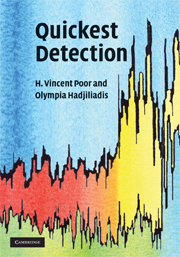1 - Introduction
Published online by Cambridge University Press: 06 July 2010
Summary
The problem of detecting abrupt changes in the statistical behavior of an observed signal or time series is a classical one, whose provenance dates at least to work in the 1930s on the problem of monitoring the quality of manufacturing processes. In more recent years, this problem has attracted attention in a wide variety of fields, including climate modeling, econometrics, environment and public health, finance, image analysis, medical diagnosis, navigation, network security, neuroscience, other security applications such as fraud detection and counter–terrorism, remote sensing (seismic, sonar, radar, biomedical), video editing, and even the analysis of historical texts. This list, although long, is hardly exhaustive, and other applications can be found, for example, in. These cited references only touch the surface of a very diverse and vibrant field, in which this general problem is known variously as statistical change detection, change–point detection, or disorder detection.
Many of these applications, such as those in image analysis, econometrics, or the analysis of historical texts, involve primarily off–line analyses to detect a change in statistical behavior during a pre–specified frame of time or space. In such problems, it is of interest to estimate the occurrence time of a change, and to identify appropriate statistical models before and after the change. However, it is not usually an objective of these applications to perform these functions in real time.
- Type
- Chapter
- Information
- Quickest Detection , pp. 1 - 5Publisher: Cambridge University PressPrint publication year: 2008



